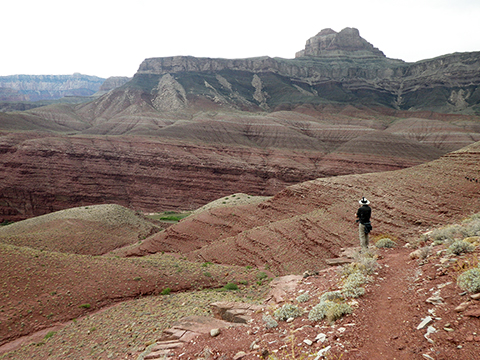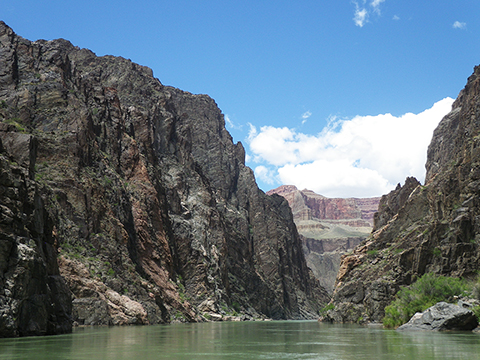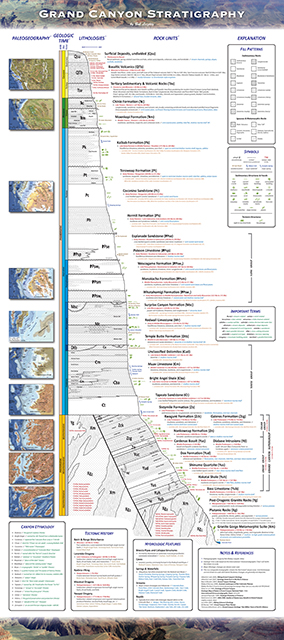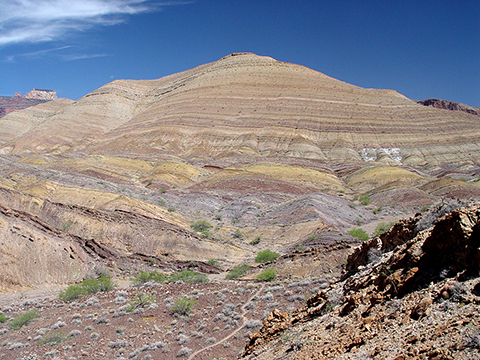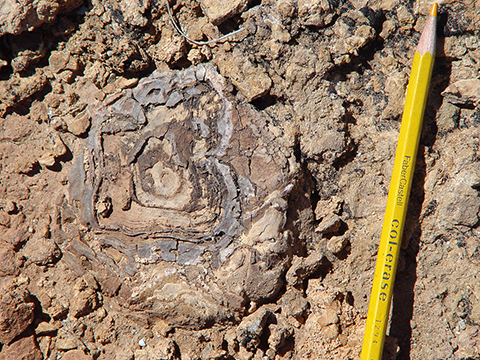Part C
Proterozoic Geology of the Grand Canyon
Rocks of Proterozoic age are exposed across the Southwest, including in the mountains and canyons of Arizona. Let's look at the Proterozoic geology of Arizona's biggest canyon, the Grand Canyon.
|
Figure 9-5. Proterozoic landscapes of the Grand Canyon. The softer sedimentary rocks of the Grand Canyon Supergroup underlie the wide vistas of the eastern Grand Canyon. At left, Kurt pauses in the Dox Formation to lookacross the Colorado River northward towards Apollo Temple. |
|
Grand Canyon Stratigraphy
Proterozoic geology is displayed within the depths of the eastern part of Grand Canyon National Park. Neoproterozic sedimentary units of the Chuar Group are only present from Marble Canyon to past Desert View, whereas the Mesoproterozoic rocks of the Unkar Group are locally present farther downriver. Downstream of Hance Rapids begins the Inner gorge, which is dominated by Paleoproterozoic igneous and metamorphic rocks like the Vishnu Schist, Brahma Schist and Gneiss, Zoroaster Granite, etc. These rocks are exposed throughout most of the entire length of the Grand Canyon, not just in the eastern part.
To help understand the Grand Canyon's gelogic complexities, the Grand Canyon Stratigraphy poster was designed to be a highly detailed stratigraphic reference graphic. This stratigraphic poster has it all: rock units, ages, depositional environments, fossils, paleogeography, and even an explanation of names! We will use this resource as we research the geology of the Grand Canyon.
|
|
|
Figure 9-6. The Grand Canyon Stratigraphy poster. |
Answer Quiz Me! questions C17 through C25 using the Grand Canyon Stratigraphy poster (see the PDF link below).
|
Grand Canyon Stratigraphy |
Plutonic Rocks & Granite Gorge Metamorphic Suite
![]()
![]()
Grand Canyon Supergroup
![]()
![]()
![]()
![]()
![]()
Tectonic History
![]()
Canyon Etymology
![]()
Geologic Map of the Eastern Grand Canyon Area
Hiking across and rafting through the eastern Grand Canyon area reveals a desolate, but enchanting Proterozoic wilderness. While Paleoproterozoic rocks dominate the Inner Gorge farther west, this part of the Grand Canyon has abundant Mesoproterozoic rocks and is the only area in the Canyon where Neoproterozoic rocks are exposed.
|
Figure 9-7. The Neoproterozoic Chuar Group of the eastern Grand Canyon. At left, a view of the multi-colored sedimentary layers of the Galeros Formation in the Carbon Creek area. At right, a solitary stromatolite (fossilized algae) in cross section, showing well-defined internal layering (it somewhat resembles a sliced head of lettuce). This stromatolite grew in sheltered tidal area roughly 770-750 million years ago and represents the dominant life form on Earth during Proterozoic time. |
|
Answer Quiz Me! questions C32 through C43 using the Geologic Map of Eastern Grand Canyon (see the PDF links below).
|
Geologic Map of Eastern Grand Canyon |
|
(it's a big map, so it may take a minute to load) River miles are marked on the map. |
|
Geologic Map of Eastern Grand Canyon - Cross Section B-B' |
List of Map Units
![]()
![]()
![]()
![]()
![]()
Geologic Map
![]()
![]()
![]()
![]()
![]()
![]()
![]()
![]()
![]()
![]()
![]()
Cross Section B-B'
![]()
![]()
